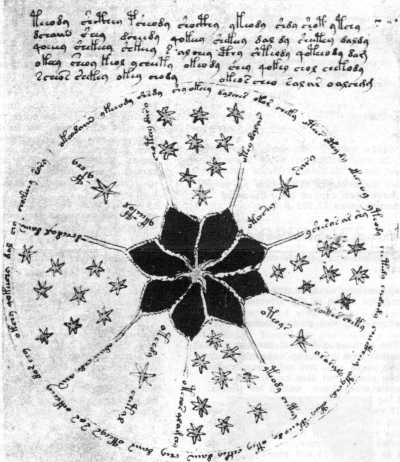 |
Science Frontiers ONLINE No. 135: MAY-JUN 2001 |
|
|
The Most Mysterious Manuscript
The words look as if you could read them easily, but you cannot. No one has been able to, except for the interpretation of a few plant labels. The words represent no known language, yet statistical tests confirm that a real language was used. "Real" but uncrackable after much labor by leading cryptographers. The plants look like species you might find in your backyard and nearby fields. Botanists, though, assure us that most do not exist in nature. The copious plant labels in that unreadable language are of no help.
Astronomical drawings and zodiacs fill some pages. Hope rises when we see a zodiac beginning with Pisces but fades when Scorpius turns out to be a lizard. Cancer is represented by two lobsters; Gemini by a man and woman.
Superficially, the manuscript seems so readable and comprehensible, but its meaning forever slips away like the grin on the Cheshire cat. One student of the Voynich Manuscript, Rene Zandbergen, ventures that the problem goes beyond hidden codes and messages; i.e., it has deeper meanings.
The Manuscript probably dates from the late Middle Ages, based upon a medieval crossbow drawn on one page. Down the years, the book has passed through many hands, including John Dee (1527-1608). It now resides at Yale University.
Who wrote the Voynich Manuscript? Polymath Roger Bacon is usually mentioned. Given his interest in ciphers and the occult, this surmise is not unreasonable. (Schaefer, Bradley E.; "The Most Mysterious Astronomical Manuscript," Sky Telescope, 100:40, November 2000. Ber man, A.S.; "Try Your Hand at Cracking the Uncrackable," USA Today, August 3, 2000. Cr. V. White via L. Farish.)
Comment. We have passed lightly over a big subject. For more, visit: www.vonich.nu Or read: Brumbaugh, Robert S.; The Most Mysterious Manuscript, Carbondale, 1978.
As for Roger Bacon, it has been claimed that he wrote some of Shakespeare's plays and, further, that these acknowledged works of genius even include an embedded cipher, which, like the Voynich Manuscript, has never been decoded.
 One of the astronomical diagrams in the Voynich Manuscript. The meaning of the star symbols in the eight (not the Zodiacal twelve!) sectors is obscure. The language used in the accompanying text is likewise mysterious. |
Other Sites of Interest
|